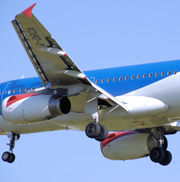Wing
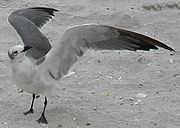
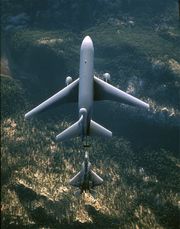
A wing is a surface used to produce lift for flight through the atmosphere - or occasionally through another gaseous or fluid substance. Another word for an artificial wing is an airfoil, and airfoils always have a distinctive cross-sectional shape.
The word "wing" for many centuries (reportedly) referred only to the foremost limbs of birds, but the meaning of "wing" has been extended in recent centuries to include the wings of insects), bats, pterosaurs, and airplanes. The term "wing" has also been applied to an inverted airfoil that is used to generate a downward force on a race car to increase its traction in automobile racing.
There is an interesting example of living things using wings in water rather than air. The various species of penguins and their close relatives (such as auks) of flightless birds are avid swimmers, and they use use their (rather small) wings to swim through seawater. Penguins, etc., etc., jump in the water and then swim around in search of the small fish that are the primary ingredient in their diets. Then, when they have eaten all they need, they swim rapidly toward the shore (usually icebound), pop out of the water, and bound onto the solid surface.
A wing's aerodynamic quality is expressed as its lift-to-drag ratio. The lift generated by a wing at a given speed and angle of attack can be one to two orders of magnitude greater than the total drag on the wing. A high lift-to-drag ratio means that a significantly smaller thrust can be applied to the airplane to propel its wings through the air and obtain the desired lift.
Contents |
Design features
Airplane wings may feature some of the following:
- A rounded leading edge cross-section
- A sharp trailing edge cross-section
- Leading-edge devices such as slats, slots, or extensions
- Trailing-edge devices such as flaps or flaperons (combination of flaps and ailerons)
- Ailerons (usually near the wingtips) to roll the airplane clockwise or counterclockwise about its long axis
- Spoilers on the upper surface to disrupt the lift and to provide additional traction to an airplane that has just landed but is still moving.
- Vortex generators to help prevent flow separation in transonic flow
- Wing fences to keep flow attached to the wing by stopping boundary layer separation from spreading
- Winglets to keep wingtip vortices from increasing drag and decreasing lift
- Dihedral, or a positive wing angle to the horizontal. This gives inherent stability in the roll direction. Anhedral, or a negative wing angle to the horizontal, has a destabilizing effect
- Folding wings allow more aircraft to be carried in the confined space of the hangar deck of an aircraft carrier.
- Variable-sweep wing or "swing wings" (in the jargon) to allow outstretched wings during low-speed flight (i.e. take-off and landing) and swept back wings for high-speed flight (including supersonic flight, such as in the F-111 Aardvark, the F-14 Tomcat, the Panavia Tornado, the MiG-23 the MiG-27, and the B-1B Lancer warplanes.
The aerodynamics of wings
The design and analysis of the wings of aircraft (and of certain spacecraft, i.e. the NASA Space Shuttle) is one of the principal applications of the science of aerodynamics. Aerodynamics is a branch of fluid mechanics, and the properties of the airflow around any moving object can - in principle - be found by solving the Navier-Stokes equations of fluid dynamics. However, these equations are notoriously difficult to solved except for in simple geometries. Hence approximations must be used.
In order for a wing to produce "lift", its "leading edge" must be pointed at a correct angle (within a certain range) into the relative flow of air past the aircraft. In this case, a region of lower-than-normal air pressure is generated over the top surface of the wing, with a higher pressure existing on the bottom of the wing. {See: airfoil.) This higher pressure on the bottom of the wing is generally the normal atmospheric pressure, plus or minus a small percentage. Using instrumentation, these air pressures can be measured (There is no question that the difference in pressure exists.), and otherwise, they can be calculated approximately using basic physical principles, including Bernoulli's Principle. A simple digram shows how Bernoulli's Principle is applicable. That is beyond question.
The lower air pressure on the top of the wing generates a smaller downward force on the top of the wing than the upward force generated by the near-normal air pressure on the bottom of the wing. Hence, the net force on the wing is clearly upward, and this force is called the "lift" generated by the wing. This is how the pressure difference between the upper and lower regions produces an upward force on the wing, the lift.
The different velocities of the air passing by the wing, the air pressure differences, lift on the wing are intrinsically one phenomenon. It is therefore possible to calculate the values of any two of these from knowledge of the other one. For example the lift can be calculated from the pressure differences, or from different velocities of the air above and below the wing. There are doubtless other approaches in fluid dynamics to solving these problems. All of these approaches will result in the same answers if done correctly. Given a particular wing and its velocity through the air, there can be debates over which mathematical approach is the most convenient to use can be misperceived by novices (especially ones not knowledgeable in higher mathematics) as differences of opinion about the basic principles of flight. These debates often create unnecessary confusion in the minds of layman.
For a more detailed coverage see lift (force).

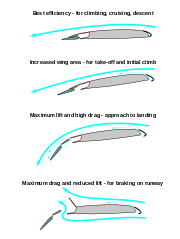
A common misconception is that it is the shape of the wing that is essential to generate lift by having a longer path on the topside compared with the underside. Wings with this shape are always used in subsonic flight and in sailing. However, in supersonic flight symmetrically-shaped wings (above and below) can generate lift by using a positive angle of attack and deflecting air downward. This design with symmetric surfaces is less efficient, and it lacks the lift provided by cambered wings at the zero angle of attack.[1]
The source of the above type of lift is a point of contention (see the talk pages of this article), with various people ascribing its source to the Venturi effect (one very similar to the Bernoulli effect), some to the Coanda effect, and some even asserting that neither one of these is relevant.
The common shapes of airplane wings also depend on a large number of factors that are not at all related to their aerodynamics. For example, most aircraft wings need great strength, and hence they need to be thick enough to contain strong structural units such as trusses, spars, beams, tubes, and rods. Many wings also need space to contain items such as fuel (for the so-called "wet wing", but not all airplanes have these, flight control units, and retractable landing gear.
The primary aerodynamic requirement on the cross-sectional shape of the wing is the need to keep air flowing smoothly over the entire surface of the wing to generate the required lift and to minimize turbulence (which creates parasitic drag and other problems). For instance, there is a requirement to prevent the gradient of the low-pressure air over the rear half of the wing fromt becoming too large. This would in effect “suck” the flowing air off of the surface of the wing. If that happened, then the wing surface from there rearwards becomes practically useless.
The shape chosen by the wing designers is always a compromise that dependeds upon
A. The intended operational ranges of airspeed, angle of attack, aerial maneuvers, and altitude.
B. The load (mass or wight) carried by the wing.
C. The strength required by the wings - including the strength needed for carrying the airplane's engines, weapons, if any, and flying in stormy weather, if necessary.
D. Factors such as must the wing contain fuel tanks, retractable landing gear, and other things that are secondary to it function to provide lift.
Here is an example of the considerations that faced the designers of a very well-known, large, heavy, warplane that has been in service for many decades: the Boeing B-52 Stratofortress.
A. The B-52s maximum airspeed is high subsonic, and it was designed to fly at high altitudes. It has low requirements on its range of angle attack and aerial maneuvers.
B. The B-52 is a large extremely heavy warplane, designed to carry a huge load of jet fuel for long range, and extrememly heavy weapons, including (formerly) nuclear weapons weighing 40,000 pounds, or a huge load of conventional aerial bombs.
C. The wings of the B-52 needed to be extremely strong just to carry its huge mass, and the large amount of jet fuel carried in its "wet wings". Also, it has eight powerful turbofan engines, all mounted in pods beneath its wings, and none in its fuselage. It was also designed to carry one quite-large Hound Dog cruise missile under each wing (long since retired from service, but replaced by other heavy weapons for it to carry). The wings had to have extra stength for flying in stormy weather, because it is a warplane that flies in fair weather or foul weather.
D. As already mention, the wings of the B-52 are "wet wings" that carry a large amount of jet fuel. On the other hand, the main, heavy landing gear of the B-52 is not in its wings, but rather they are mounted directly onto its fuselage, and they retract into its fuelage. The B-52 just has one light landing gear assembly in each wingtip, but they are there to keep the wingtips from dragging on the ground while taking off or landing.
Usually aircraft wings have various devices, such as flaps and/or slats. which allow the pilot(s) to modify shape and surface area of the wing to be able to change its operating characteristics in flight.
In 1948 Francis Rogallo invented the fully limp flexible wing which ushered new possibilities for aircraft. Near in time Domina Jalbert invented flexible un-sparred ram-air airfoiled thick wings. These two new branches of wings have been since extensively studied and applied in new branches of aircraft, especially altering the personal recreational aviation landscape.
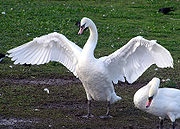
The science of wings applies in other areas beyond conventional fixed-wing aircraft, including:
- Hang gliders which use wings from fully-flexible (paragliders, gliding parachutes) wings, flexible wings (framed sail wings), to rigid wings.
- Kites which use a vast variety of wings.
- Flying model aiplanes
- Helicopters which use a rotating wing with a variable pitch or angle to provide directional forces
- The NASA Space Shuttle which uses its wings only for the lift needed during its descent to a runway. This is the world's only spacecraft that uses this method.
- Some racing cars, especially Formula One cars, which use upside-down wings, (or airfoils) to give the cars greater traction at high speeds over 100 mph.
- Sailboats which use sails as vertical wings with variable fullness and direction to move across water.
Structures with the same purpose as wings, but designed for use in liquid media, are generally called fins or hydroplanes, with hydrodynamics as the governing science, rather than aerodynamics. Applications of these arise in craft such as hydrofoils and submarines. Sailboats and sailing ships use both fins and wings.
See also
- Bird flight
- Flight feather
- Flying and gliding animals
- Insect flight
- Kite types
- List of soaring birds
- Flight
- Planform
- Wing configuration
- Wing suit
References
- ↑ E. V. Laitone, Wind tunnel tests of wings at Reynolds numbers below 70 000, Experiments in Fluids 23, 405 (1997). doi:10.1007/s003480050128
External links
- How Wings Work - Holger Babinsky Physics Education 2003
- "Physics of flight - revisited" Weltner and Ingelman-Sundberg
- How Airplanes Fly: A Physical Description of Lift
- Demystifying the Science of Flight - Audio segment on NPR's Talk of the Nation Science Friday
- NASA's explanations and simulations
- Flight of the StyroHawk wing
- See How It Flies
